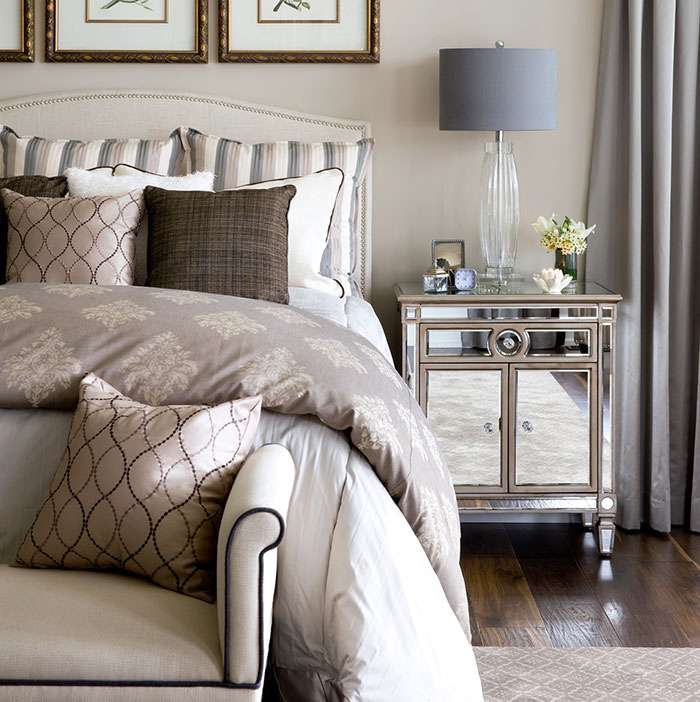I recently did a segment on The Marilyn Denis show and touched upon the proper way to make a bed and all of the items every bed should have. I suddenly realized that this is something that needs to be shared.
Extending the comfort of your mattress
To start with, if your bed is uncomfortable or if you need a little added cushion, try a feather bed or a memory foam mattress topper. Next are the sheets, which actually make a large difference.
If you are naturally prone to being cold throughout the night, stay away from sateen sheets. Alternate choices can include percale or flannel. Percale will keep you warm, and if you really need heat, flannel is the best option. Sateen sheets are the ideal choice if overheating is an issue throughout your slumber.
The great pillow debate!
Next, pillows, pillows and more pillows! I know the husbands will never understand our obsessions with pillows, but in my opinion, the more the better!
The size of your bed will determine the size of the pillows. If you have a king bed, go with king pillows, queen bed, queen pillows, etc.

Start with two sleeping pillows and make sure to take care in choosing these. Depending on how you sleep, you may require a specific structure. Also, give thought to synthetic versus feather, there are pros and cons to each.
The next set of pillows will fill the matching shams to the duvet. As these will only be used for display, make sure they are nice and full. Once the bed is made, to finish off the look, add a set of euro pillows in addition to assorted throw pillows.
Duvet vs. comforter
I like to go with a duvet and duvet cover versus a comforter. This way, you can interchange your duvet depending on your body temperature and the season. Another great advantage to a duvet is being able to change it easily as the style of your room changes. Again, the duvet can be purchased in feather or synthetic, so do your research before you make an investment. Here is a top-secret designer tip: we ALWAYS put an extra duvet under the top duvet to make the bed look extra fluffy!
The finished product!
Lastly, add a quilt or a matelassé along the bottom of the bed. The fabric of the quilt or matelassé will also be repeated on the euros. This addition should be in a neutral colour that matches the pattern, a grey or beige. To finish the bed, purchase an assortment of throw pillows in varying pops of colour that are pulled from the duvet and arrange them in front of the euro pillows.
Your bed is where you will spend the most combined hours in your lifetime. Make sure you do the proper research and create a getaway where you truly can escape all that goes on during the day!
Glossary of terms – just in case!
Source: Wikipedia
Sateen is a fabric made using a satin weave structure but made with spun yarns instead of filament.[1]
The sheen and softer feel of sateen is produced through the satin weave structure. Warp yarns are floated over weft yarns, for example four over and one under. (In a weft-faced satin or sateen, the weft yarns are floated over the warp yarns). Standard plain weaves use a one-over, one-under structure. The long floats produce a surface that is smooth to the touch and reduces light scattering to increase shine. This weave structure is more susceptible to wear than other weaves.
In modern times cheaper rayon is often substituted for cotton. Better qualities are mercerized to give a higher sheen. Some are only calendered to produce the sheen, but this disappears with washing.
Percale, or percalcos,[1] is a closely woven plain-weave fabric often used for bed covers. Percale has a thread count of about 200 or higher and is noticeably tighter than the standard type of weave used for bedsheets. It has medium weight, is firm and smooth with no gloss, and warps and washes very well. It is made from both carded and combedyarns, and may be woven of various fibers, such as cotton, polyester, or various blends.[2]
Matelassé (mat-la-SAY) is a weaving or stitchingtechnique yielding a pattern that appears quilted or padded.[1] Matelassé may be achieved by hand, on a jacquard loom, or a quilting machine. It is meant to mimic the style of hand-stitched quilts made in Marseilles, France. It is a heavy, thick textile that appears to be padded, but actually has no padding within the fabric.
For more information on pillow sizes and fills, here is a great article that explains it all!

